Introduction
Recently, the Science and Technology Section (STS) of the Association of College & Research Libraries recognized the need for discipline-specific library instruction by publishing information literacy standards specific to science, engineering, and technology (2007). These standards identify specific information needs and realities that are different from other academic disciplines. Additionally, today’s typical undergraduate students, often referred to as Generation Y, or millennials, are faced with different cultural and informational influences. Having grown up in a media rich environment with easy access to information, today’s students have different expectations than those of their predecessors. The same technologies that have helped create these expectations also enable us to meet those expectations 24/7 and in an environment where students are comfortable. The Make the Leap assignment offered by The Ohio State University Libraries is designed for these millennial students. Make the Leap is an introductory research assignment for entering freshmen and transfer students that has been expanded to include a version that targets engineering students, giving them a discipline-specific introduction to research tools.
Rationale
Introducing students to college or university level research skills and tools before a research assignment is given is tricky. But in large university settings where student curricular experiences vary widely, such introductions are necessary to raise student awareness of the vast library resources, facilities, or services when an information need arises. Introductions that are either too general or too specific, however, can run the risk of seeming irrelevant and thus useless, to students and their instructors.
Students in various disciplines will have unique research needs and library instruction should take this into consideration (Grafstein, 2002). Discipline-specific library instruction that acknowledges the differences in discourse and resources between, say, psychology and engineering and history will be more relevant. While some resources are useful for searching the literature of nearly every discipline, specialized search tools that offer excellent coverage of the literature of specific disciplines abound. Tailoring library instruction to a specific discipline allows for users to be exposed to the resources that will give the most relevant results for their literature search and will begin to introduce them to the discourse of their own field.
The new ACRL/STS standards for science and technology highlight some of the information needs unique to these subject areas. Standards that vary for the special information needs in science and engineering/technology mention costly (and sometimes locally-unavailable) journals, gray literature, and the need to examine the literature of other subjects since interdisciplinary topics are increasing in science and engineering. Several performance indicators in the standard apply to information literacy in any discipline. These include abilities to:
- Explore general information resources
- Define or modify an information need
- Define or identify differences between and a variety of formats of potential resources
- Determine the availability of needed information
- Select the most appropriate information retrieval systems for needed information
- Construct and implement effectively designed search strategies
- Retrieve information using a variety of methods
- Refine the search strategy if necessary
Various studies indicate a need for discipline-specific, lower division undergraduate library instruction. A study at Oregon State University found extensive use of the Internet by students for a particular assignment. Despite not stressing the use of article indexes in library instruction for the assignment (in fact, the authors did not believe article indexes would be appropriate for the assignment), a number of students used a general periodical database, which was not a good source of information for the topic (Webster and Rielly, 2003). These students perhaps still did not know how to identify the types of information resources that should be used and what information retrieval resources to use to find those resources. It is telling that even though the students did not need to use a periodical database at all, they gravitated toward using a general one instead of one more specific to their subject area. Students grasped the possible need to use more than a search engine for their research, but perhaps still needed a bit more guidance on what other tools are available and when they are useful for a specific information need. While a general periodical database may find some information on most topics, some students are unaware of subject-specific databases that could be better sources for more detailed information on a topic with a clearly-defined subject area.
Leckie and Fullerton (1999) found that students in the sciences did not tend to do extensive research within their discipline until very late in the undergraduate years or possibly not even until their graduate years. In some science disciplines, teaching faculty placed less importance on the library’s role for undergraduates than colleagues in other disciplines. In addition, they placed lower importance on library instruction in early undergraduate years than in later undergraduate years. Faculty in the sciences also tended not to know how students developed information research skills, but found an improvement by their later undergraduate years and assumed that the students who did not develop better skills were unmotivated, uninterested, or just poor students. Another finding was that faculty seemed unaware that librarians would be willing to work with them in developing subject-specific library instruction. Callison, Budny, & Thomes (2005) state that it is common to hear junior and senior engineering students say they do not know how to do research in their own discipline.
Macpherson (2004) further makes the case for lower-level undergraduate information literacy efforts. She argues that teaching information literacy, critical thinking, and end-user computing to students “at the start of any first-year undergraduate program is likely to enhance significantly their understanding of many of the academic requirements that will be encountered during their studies” (p. 234).
Beside the need for discipline-specific information literacy, the pedagogy used to teach it should be thoughtful. The Association of College and Research Libraries (2003) outlines a variety of characteristics that define best practices for information literacy programs. One centers on pedagogy that makes use of technology, includes interactivity, and encompasses critical thinking and reflection.
Many librarians have studied the research habits of Generation Y or millennials. Student research often begins with the Internet (Costello, Lenholt, & Stryker, 2004; Harley, Dreger, & Knobloch, 2001). While Generation Y students have grown up with technology, they often overestimate their abilities in searching the Internet for information (Monoi, O’Hanlon & Diaz, 2005 p. 103), in evaluating the information they find, and in determining the quality of information on the Internet (Harley et al., 2001; Costello et al., 2004; Manuel, 2002). If these students branch outside web search engines and use library research databases, they tend to gravitate towards familiar resources, such as general databases (Costello et al., 2004). By sticking with the familiar, students fail to learn about the wealth of information being produced in their fields and the more valuable and specific resources available. It makes sense then, that the 2007 Horizon Report states as a key trend that:
Information literacy increasingly should not be considered a given. Contrary to the conventional wisdom, the information literacy skills of new students are not improving as the post-1993 internet boomlet enters college. At the same time, in a sea of user-created content, collaborative work, and instant access to information of varying quality, the skills of critical thinking, research, and evaluation are increasingly required to make sense of the world. (New Media Consortium, 2007, p.4)
The 2008 Horizon Report continues the call for information literacy and defines the need as a “critical challenge”, calling for “formal instruction” in this as well as visual and technology literacy. (New Media Consortium, 2008, p.6)
A variety of studies echo the call for visual literacy instruction, as issued by the Horizon Report, indicating that ours is an increasingly visual culture and that using visual elements for teaching is of great importance and will result in better learning. (Kipnis & Childs, 2004; Costello et al, 2004; Harley et al, 2002; Manuel, 2002). Other teaching methods deemed useful for reaching Generation Y students include virtual interaction and delivery, hands-on exercises (Harley et al., 2001), discovery-based learning, directions that make use of visuals more than text, choice, customization, and scaffolding (Manuel, 2002). Ideally, librarians would have the opportunity to interact with students in order to learn their skill level, their gaps in knowledge and their true learning needs.
Finally, McDonald and Thomas complain that academic libraries have “done little to embed themselves and their resources into the everyday tools, spaces, and activities important to today’s learners” (2006, p.4). On a related note, Nichols and Mellinger indicate that rather than providing subject portals, libraries should focus on providing “ the construction of library Web pages for particular courses or course assignments.” (2007, p. 488)
The Make the Leap Program
The Ohio State University Libraries’ Make the Leap (MTL) assignment provides a model that addresses the needs of millennials. It is an introductory, interactive assignment provided through a course-management system (CMS) which gives students exposure to research skills in using an internet search engine (Google), a research database (EBSCO’s Academic Search Complete, a general research database that has materials on a wide variety of topics and contains full text), and the library catalog.
When MTL began in 2004, about 3,900 students enrolled in introductory survey courses on the OSU main campus and regional campuses were given the assignment during the academic year. Usage has increased to over 5,300 students in the 2007-08 academic year. With over 6,000 new freshmen on the main (Columbus) campus alone, the program does not reach every new student, but is the most comprehensive introduction to the library and information resources available.
Students log in and pick a topic to use throughout the assignment. The notion of consumer choice is one important element in the postmodern expectations of millennials (Harley et al, 2001) and topic choice addresses this need. Because the assignment is automatically graded, choice is offered within parameters.
A brief overview of the resource provides students with context. They are then asked to perform searches and answer questions about their search making it active and hands-on.
Each question leads students through various features of the search tool. After completing and submitting each section or quiz, they receive feedback and the opportunity to retake the quizzes and correct any mistakes which allows for discovery-based learning and even superficial attempts. A fourth quiz calls on students to use critical thinking and apply the skills learned in the quizzes to new theoretical research problems and is available for only one attempt.
Some questions throughout provide links to short animated demonstrations of features that might not be familiar to them (Figure 1). If students do not need the instruction, they do not need to view them. This addresses knowledge fragmentation problems noted by Harley (2001).

Figure 1. Availability of animated demonstrations
A visual summary of the MTL assignment is provided in Table 1. One common feature of the first three quizzes is for students to do a search and then add a second term to their search (as a Boolean AND search) to show that being more specific will give fewer results. Another common feature is for students to explore limiting features, such as limiting to location and year in the catalog, limiting by article type in the periodical database, and limiting by domain in Google. The catalog and periodical database quizzes also explore subject searching to introduce the concepts of controlled vocabulary and alternate search terms.
Table 1. Summary of assignment
Quiz |
Description |
Background Information (Google) |
Search for background information, using the advanced search to enter multiple search terms and to limit to a specific domain (.edu or .gov) |
Articles (Academic Search Complete) |
Use the database to search for articles then locate local electronic and/or print availability through a resolver. |
Books (Library Catalog) |
Use the catalog to search for books, understand subject vs. keyword searching, and learn to limit (such as by year and location) |
Apply Skills (summary) |
Review the above quizzes by applying knowledge and selecting what tools best suit specified information needs. |
MTL is managed as a separate course within the CMS into which students are enrolled enabling the library to become embedded in everyday places. Worksheets, or quizzes as they are labeled in the CMS, are graded automatically and are available for students to review. Graded assignments provide feedback for each question so students can receive further instruction if they do not understand a particular concept or rationale. An email link for a librarian is provided so that students can contact a librarian if they have a question about the assignment. After the students’ access time is over, a librarian downloads the scores and emails them to the course instructor to include in his or her class gradebook, providing an incentive for students to participate.
Make the Leap is an active learning assignment. Students interact with a live, authentic system, and search. They report their findings in a quiz interface. They make inferences from their experience. Because Make the Leap exists within the CMS, it provides the advantage of what Ladner, Beagle, Steele & Steele (2004) call the “classroom flip.” While this assignment can be accompanied by a classroom presentation if the faculty member wishes, it does not have to be. It can teach and provide interactivity for students outside of the precious classroom time. It provides practice time with immediate feedback.
Make the Leap starts with what students probably already know (Google) and builds on that knowledge. This is designed to respect that students already bring experience to the process and provides them with context for their knowledge. It then widens their understanding of what is available to them. The assignment also addresses the millennial’s consumer notion of convenience. All the resources they search are available online, through the assignment itself. There is no need to go elsewhere, and students learn that even scholarly information can be convenient.
By placing this exercise in the CMS, the library is present in the environment that an increasing number of students need to regularly access in order to accomplish their schoolwork. It is a tool with which they are familiar, that allows them to work anytime day or night, check their scores and progress, and refer back to as needed, providing much of that convenience that feeds the consumer needs of students discussed by Harley et al (2001). And, it is one assignment in a class with other assignments that relate to the general process of preparing to be a student at a large university.
The Engineering Version
When OSU switched course management systems (from WebCT to Desire2Learn, known locally as Carmen), MTL needed to be retooled to function properly in the new environment by the Autumn 2006 quarter. This provided an excellent opportunity to make some changes to the assignment. One major enhancement was to create a second, separate version of Make the Leap specifically targeted to the engineering survey courses.
The engineering survey courses (ENG 100) altogether typically enroll close to 1,000 students each fall quarter. The College of Engineering has several departments and students enroll in the ENG 100 course section that is designated for their major. The course description for ENG 100 states that it covers “ University procedures, grading system, and resources; overview of engineering academic areas of study and services” (University Registrar, 2007-08, p. 103). The MTL assignment addresses these goals by giving students an overview of information resources available to them.
The Engineering version of the MTL assignment is structured the same as the original version, but provides students with three engineering topics. The topics chosen relate to engineering disciplines that had previously used the assignment. Currently they are: computers (for computer science), bridges (for civil engineering), and rockets (for aviation and aerospace engineering). Figures 2 and 3 show the top level pages for the original and engineering versions of the MTL assignment.
Besides different topic options, the engineering version includes links to a handout of the slides from the optional in-class Power Point presentation and also to a handout called Engineering Finding Tools Coverage, which allows users to see what searching tools best work with the various engineering subject areas.
Not visible from the top level page is another change in the Engineering version, that of periodical database. In the original version, EBSCO’s Academic Search Complete is a database that has a broad coverage of a wide variety of topics. However, it is not the ideal database to use for engineering topics. A reference librarian would not generally refer students searching for various computer science or engineering topics to this database when searching for articles. While students would get some search results, the better results would generally be available from a database specifically targeted to engineering and computer science topics. Figures 4 and 5 compare the original and engineering version quizzes for a periodical database.
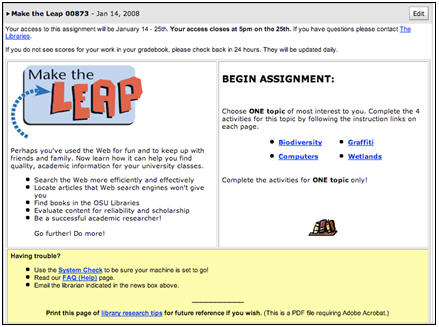
Figure 2. Original MTL top level page
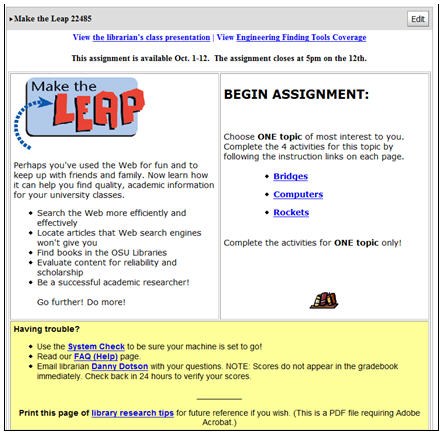
Figure 3. Engineering MTL top level page
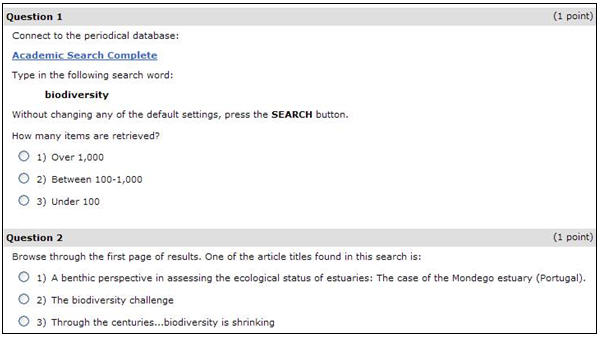
Figure 4. Sample questions from Original MTL periodical (Academic Search Complete) quiz
Compendex (the 1969 to present version) was chosen as the research database for students to use in the engineering MTL assignment. It has good coverage of computer science and engineering topics, which allows for consistency of experience for students and streamlined implementation and maintenance of the assignment for the librarians.
The Google section also saw some slight changes from the original MTL assignment. Government and academic information is important to people in engineering fields. This portion of the assignment instructs the students to use the advanced search features in Google and limit their search to a specific domain. In two of the three topics, students limit their search to the .gov domain and the other assignment to the .edu domain.
Although students have the option to request books to be delivered from one library to another library on this large, multiple-facility campus, it is likely students in engineering and computer science would be most familiar with the Science and Engineering library. Thus, the engineering version of the library catalog quiz leads students to use the limit/sort option available in the library catalog to limit to that specific location. Since currency is often highly critical in the sciences, students learn how to find the most current materials in the library catalog.
The summary quiz questions are very similar between the two versions of the assignment. As with the original assignment, the summary quiz focuses on applying the information gained from the assignment and asks students to determine which resource would be the best to use for a future, particular research need. Figures 6 and 7 compare some questions from the summary quiz.
As an introductory assignment, the Engineering version of Make the Leap primarily addresses standards one and two of the ACRL/STS information literacy standards (2007). Table 2 summarizes how MTL leads students through various performance indicators within the standards.
Make the Leap encompasses the triad of skills outlined by Macpherson (retrieval, analysis of findings, and technical use of various systems to complete the assignment). Macpherson (2004, p. 240) argues that, “When information literacy, critical thinking and end-user computing are viewed as parts of a whole, the issue is not one of 'training', but of education; the aim is not to teach 'skills', but to develop theoretical frameworks for ' 21 st century literacy essential for any graduate to possess.”
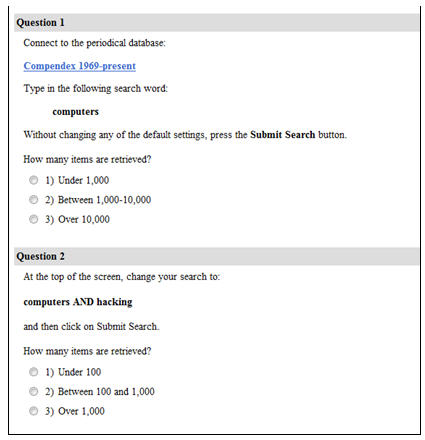
Figure 5. Sample questions from Engineering MTL periodical (Compendex) quiz
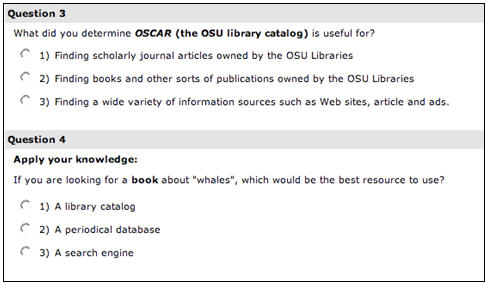
Figure 6. Summary quiz sample questions from Original MTL .
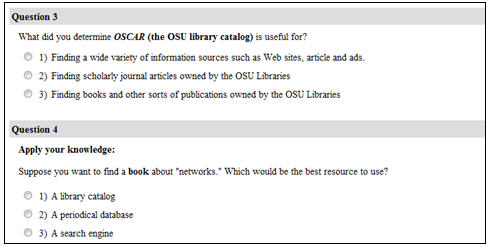
Figure 7. Summary quiz sample questions from Engineering MTL .
Table 2: MTL and the ACRL/STS standards
Performance indicators from ACRL/STS Standards.
The information literate student: |
Corresponding MTL activities |
Explores general information resources (Standard 1), and
Retrieves information using a variety of methods (Standard 2) |
Students conduct searches for information in Google, a periodical database, and the library catalog. |
Identifies the differences between potential resources in a variety of formats (Standard 1) |
Students are shown the differences between books, articles, and web pages and how the resources differ. |
Determines the availability of needed information (Standard 1) |
Students are shown how to check for an article’s availability in the periodical database. |
Selects the most appropriate information retrieval systems for needed information (Standard 2) |
Students analyze findings from the three discovery tools in the assignment and are led to consider the best uses for each of those search tools. |
Defines or modifies an information need (Standard 1), and
Constructing and implements effectively designed search strategies (Standard 2), and
Refines the search strategy if necessary (Standard 2) |
Students discover that a general search on a broad topic often results in too many hits. They are shown how to modify search strategies with additional terms and through limiting for more appropriate results. Subject searching (controlled vocabulary) is also explored in the catalog and periodical database for alternate search terms. |
Findings
The engineering version of MTL debuted in autumn quarter 2006 with 129 students in engineering sections for aviation and computer science using the assignment. In autumn 2007, all instructors for ENG 100 sections were contacted about using the engineering version of the assignment. Civil engineering, electrical and computer engineering, and materials science instructors all added the assignment to their curriculum. In addition, mechanical engineering students were offered the assignment as an option amongst several graded assignments from which students had to choose. This resulted in a total of 623 students enrolled, more than the previous three years combined. (Before the Engineering version was created, ENG 100 had 197 participants in MTL in 2004 and 277 in 2005.) This is an indication that survey instructors found greater value in an assignment customized for engineering.
The majority of students did in fact choose to use the topic related to their major for the assignment. Table 3 indicates the percentage of students completing each topic by academic major.
Table 3: Topic completion by academic major
Major |
Autumn 2006 |
Autumn 2007 |
|
Bridges |
Computers |
Rockets |
Bridges |
Computers |
Rockets |
Computer Science |
14.0% |
77.4% |
8.6% |
6.7% |
81.5% |
11.8% |
Electrical and Computer Engineering |
|
|
|
13.4% |
67.2% |
19.3% |
Civil Engineering |
|
|
|
85.3% |
10.7% |
4.0% |
Aviation |
20.0% |
20.0% |
60.0% |
11.1% |
44.4% |
44.4% |
Materials Science |
|
|
|
28.6% |
28.6% |
42.9% |
Mechanical Engineering |
|
|
|
31.4% |
27.5% |
41.2% |
As indicated in the chart, 77.4% of computer science students chose computers and 60% of aviation
students chose rockets. In 2007, similar results occurred, with 81.5% of computer science students choosing computers, 67.2% of electrical and computer engineering students choosing computers, and 85.3% of civil engineering students choosing bridges. Aviation was slightly off from the previous year, with only 44.4% choosing rockets. Students majoring in the subject areas of materials science and mechanical engineering, which did not have a topic closely related to their major, chose from all topics evenly, with rockets receiving slight majorities. Overall, topic choice indicates a preference towards relevance.
In both 2006 and 2007, a number of students took an optional survey about the assignment. In general, students felt confident using the resources, especially Google. Students responded with more confidence in using the web search engine, however, than in using the library catalog or the periodical database, indicating that undergraduates are not as familiar with these tools. It is also interesting to note that while the majority of students consider themselves to be highly skilled users of web search engines, 10% of students lacked such over arching confidence in 2007 (see Table 4). Because they complete this survey after finishing the assignment, it might be that the assignment has made many students realize that there are web resources and search features available of which they were previously unaware.
Student comments reflected other sentiments towards the assignment. Some felt the assignment was a good activity for learning what search tools are useful for various needs. One student, however, commented that such an assignment is inappropriate for computer science students given their skills with computers. This comment may reflect the overconfidence in research skills noted earlier, and may indicate that those with more advanced technical skills might think research skills are the same as technical skills.
User data by quiz and by question provided by the CMS makes it easy to find questions that a large percentage of users get wrong. This data showed that most students were able to answer most questions correctly. It was clear that one question gave particular trouble to students in the summary quiz, however. In this question, students are asked to identify which resource is most useful for identifying the most recent and up-to-date information about rockets in use by various space agencies. By revising the information in the final summary instructional page and quiz to more clearly identify search engines as a timely source, students are better able to choose the correct answer to the question.
Table 4: Student survey results
|
Autumn 2006 |
Autumn 2007 |
Total responses |
17 |
119 |
Rate web experience prior to assignment |
|
|
Highly skilled
|
76.5% |
55.5% |
Somewhat skilled
|
23.5% |
41.2% |
No experience
|
0.0% |
3.4% |
Ease of Assignment |
|
|
Very Easy
|
94.1% |
73.9% |
Somewhat Easy
|
5.9% |
24.4% |
Not easy at all
|
0.0% |
1.7% |
Confident in using a search engine |
|
|
Very
|
100.0% |
90.8% |
Somewhat
|
0.0% |
8.4% |
Not at all
|
0.0% |
0.8% |
Confident in using a periodical database |
|
|
Very
|
82.4% |
53.8% |
Somewhat
|
17.6% |
42.9% |
Not at all
|
0.0% |
3.4% |
Confident in using catalog |
|
|
Very
|
88.2% |
53.8% |
Somewhat
|
11.8% |
42.0% |
Not at all
|
0.0% |
4.2% |
Confidence in choosing which tool to use |
|
|
Very
|
88.2% |
73.9% |
Somewhat
|
11.8% |
21.8% |
Not at all
|
0.0% |
3.4% |
Challenges and Difficulties
While having a library presence in the CMS provides many benefits and is the right place to be, there are also significant challenges to offering an assignment such as Make the Leap. A CMS, by definition, supports courses, but Make the Leap, is an assignment, not a course. Because it requires live searching, it needs regular maintenance and updating. This is hard to do unless the librarian has access to the course. Even with access, maintenance would be unwieldy in multiple sections. Creating the assignment as a “course” makes maintenance and quality control easier, but requires system administration support for enrolling students into that course. Because many systems interact with college and university student information systems (SIS) to automatically enroll students based on the registrar’s records, a special process needs to be developed to allow non-standard enrollment such as this external assignment.
Managing an assignment of any sort for a course in which one is not the instructor, requires a strong collaborative relationship. Managing gradebooks, due dates and extensions in a manner that is seamless for students requires good communication between the course instructor and the librarian.
Librarians have long struggled with securing invitations into the classroom. This problem was not solved just by creating an interesting and highly interactive assignment. Course instructors still needed to welcome it into their learning objectives, their gradebooks, and their course requirements. The growth in use of the engineering version of MTL from 2006 to 2007 relates directly to a concerted effort by subject specialist librarians to contact survey instructors directly and explain the benefits of the assignment for this class.
Because MTL uses live, online resources, search results are anything but stable and require monitoring. This is especially true in Google for the Engineering version. Each version of MTL is reviewed just before use in a new quarter, but sometimes search results change in the middle of the assignment period. Librarians need to be ready to respond immediately to such changes and provide quick updates. The online format does make these changes immediate though, for students who have not yet completed the assignment.
Technical difficulties have occurred with MTL. Browser choice and settings can cause problems, such as having popup blockers on or using a browser that is not fully compatible with the CMS. The CMS sometimes experiences slowdowns or downtime, especially during the very heavy usage of fall quarter. In autumn quarter 2006, an upgrade to the library catalog caused several technical problems resulting in down- or slow-time at the beginning of the quarter. This resulted in some frustration for students working on the MTL assignment at the time.
Creating discipline-based versions of an introductory assignment such as MTL is beneficial to students, but requires more librarian labor. Subject specialists must be involved and help to manage this process. This requires gaining skills in using the CMS, adapting quiz questions so they are appropriate for the discipline and the article database, and maintaining the assignment for currency. Once created, the new version must also be maintained.
Not every survey course at Ohio State is well-suited for its own version of MTL. For example, the survey course for the College of Mathematical and Physical Sciences, or MAPS, (of which 270 students completed the Make the Leap assignment in the 2006-2007 academic year) does not have one single database that would work well for creating a course module. MAPS represents diverse subjects (such as mathematics, physics, chemistry, and astronomy) that each have a different “best use” database.
Future Development
The value of Make the Leap lies in providing a broad-based, systematic introduction to research materials for students. The engineering version described in this article has been one developmental step towards customizing it to individual student need and providing some of the relevant, convenient, interactive, and technology-based instruction for millennials. Since the engineering version debuted, a health science librarian has developed a health sciences version of the assignment that uses PubMed as the article database and the MESH thesaurus as an advanced feature. It is used for survey students in nursing, allied medicine, biomedical sciences, and dental hygiene. The business school, which had stopped using MTL a couple of years ago, has shown interest in using it again with this customized approach and so a business version is now in development. This will bring another one thousand or more users to the program each year. The engineering version has provided a model which has had further impact.
The revised version and targeted appeal to ENG 100 courses in fall 2007 resulted in more widespread use of the assignment. Now that the engineering version is successful, it is easier to approach other instructors in the program about including MTL as part of their course. This has provided an important opportunity for the library to make inroads into an academic discipline not always open to or mindful of the value of the library’s role in information literacy.
Another potential development for the MTL program is to create a video version of the presentation a librarian gives in courses that choose to have one given. This would use screen-capture software and narration to give general information about the libraries and an overview of the assignment. The session would be available as streaming video giving more choice to instructors and students. Instructors may prefer not to invite a librarian to present during valuable class time, so this alternative allows an introduction to be included for students to view on their own time. It also allows students who miss an in-person session to see an introduction as well. The streaming video version would likely be a shortened version of the in-class introduction, which typically takes up about 45 minutes.
One other development possibility under consideration is implementing scaffolding. The engineering Make the Leap assignment was remixed with higher-level concepts for students in a 400 level course whose instructors requested a library component. Because it was likely that many students already completed the Make the Leap assignment, “Step Beyond” addressed more advanced search techniques not covered in Make the Leap. This model is being considered as a scaffold for student experience. Ideally students would complete what is now the final (summary) assignment as a pretest. The score on the summary quiz would determine which assignment best suits each student’s needs and then open the appropriate assignment individually. This would ensure an even more customized and relevant experience. Scaffolding has not yet been implemented because it is a complex and high maintenance idea. Essentially two sets of activities for each topic would require maintenance, and if available for multiple disciplines, this would mean a tremendous amount of effort.
Conclusions
The Make the Leap assignment offered by The Ohio State University Libraries fits the learning characteristics of millennial students and addresses introductory requirements of national information literacy standards. The discipline-specific version for engineering students provides the relevance millennials desire by offering research topics for their subject area and introducing them to a subject-specific database. It has also increased the interest of survey instructors to use this assignment in their classes and has provided a model to expand this concept to other disciplines. While maintenance of the assignment remains a major issue, the assignment's relevance, and the automatic grading features of a CMS far outweigh the time used to maintain the assignment. Future directions, such as the possibility of other subject-specific versions or pretesting and scaffolding, may be taken in order to better prepare millennial students for college-level research.
References
Association of College and Research Libraries, Institute for Information Literacy (2003). Characteristics of Programs of Information Literacy that Illustrate Best Practices: A Guideline. Retrieved June 17, 2008 from http://www.ala.org/ala/acrl/acrlstandards/characteristics.htm
Association of College and Research Libraries/Science and Technology Section. Task Force on Information Literacy (2007). Information literacystandards for Science and Engineering/Technology. Retrieved June 17, 2008 from http://www.ala.org/ala/acrl/acrlstandards/infolitscitech.cfm.
Callison, R., Budny, D. & Thomes, K. (2005). Library research project for first-year engineering students: Results from collaboration by teaching and library faculty. The Reference Librarian, 89/90, 93-106.
Costello, B., Lenholt, R. & Stryker, J. (2004). Using Blackboard in library instruction: Addressing the learning styles of Generations X and Y. The Journal of Academic Librarianship, 30, 452-60.
Grafstein, A. (2002). A Discipline-based approach to information literacy. Journal of Academic Librarianship, 28, 197-204.
Harley, B. L., Dreger, M. & Knobloch, P.J. (2001). The postmodern condition: Students, the web, and academic library services. Reference Services Review, 29(1), 23-32.
Kipnis, D. G. & Childs, G.M. (2004). Educating Generation X and Generation Y: Teaching tips for librarians. Medical Reference Services Quarterly, 23(4), 25-33.
Ladner, B., Beagle, D., Steele, J. R., & Steele, L. (2004) Rethinking online instruction: From content transmission to cognitive immersion. Reference and User Services Quarterly, 43 (4), 337-345.
Leckie, G. J. & Fullerton, A. (1999). Information literacy in science andengineering undergraduate education: Faculty attitudes and pedagogical practices. College and Research Libraries, 60(1), 9-29.
McDonald, R. H. & Thomas, C. (2006). Disconnects between library culture and millennial generation values. Educause Quarterly, 4, 4-6.
Macpherson, K. (2004). Undergraduate information literacy: A teaching framework. Australian Academic Research Libraries, 35 (3), 226-241.
Manuel, K. (2002). Teaching information literacy to Generation Y. Journal of Library Administration, 36(1/2), 195-217.
Monoi, S., O’Hanlon, N., & Diaz, K. R. (2005). Online searching skills: development of an inventory to assess self-efficacy. Journal of Academic Librarianship 31(2), 98-105.
New Media Consortium. (2007). Horizon Report. Retrieved June 17, 2008 from http://www.nmc.org/pdf/2007_Horizon_Report.pdf
New Media Consortium. (2008). Horizon Report. Retrieved June 17, 2008 from http://www.nmc.org/pdf/2008-Horizon-Report.pdf
Nichols, J. & Mellinger, M. (2007)Portals for undergraduate subject searching: Are they worth it? portal: Libraries and the Academy, 7, (4), 481–490.
University Registrar, (2007-08). Course Bulletin. Retrieved June 17, 2008 from http://www.ureg.ohio-state.edu/ourweb/scheduling/SchedulingContent/07-08Undergrad.pdf
Webster, J. and Rielly, L. (2003). A library instruction case study: measuring success from multiple perspectives. Research Strategies, 19(1), 16-32 . |







